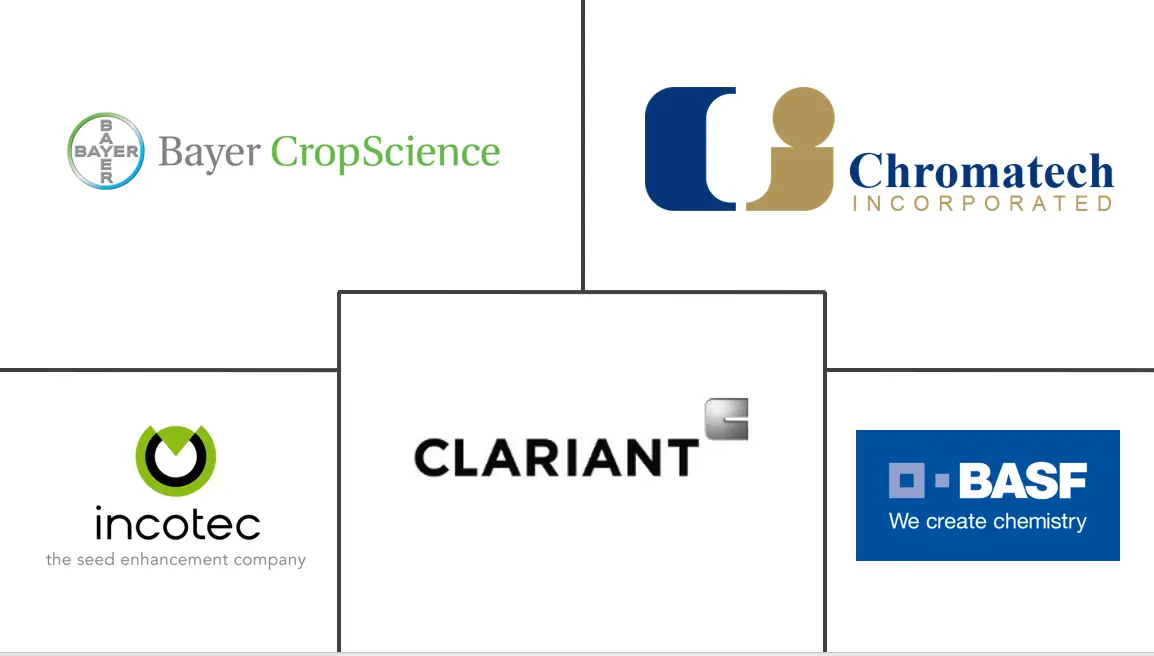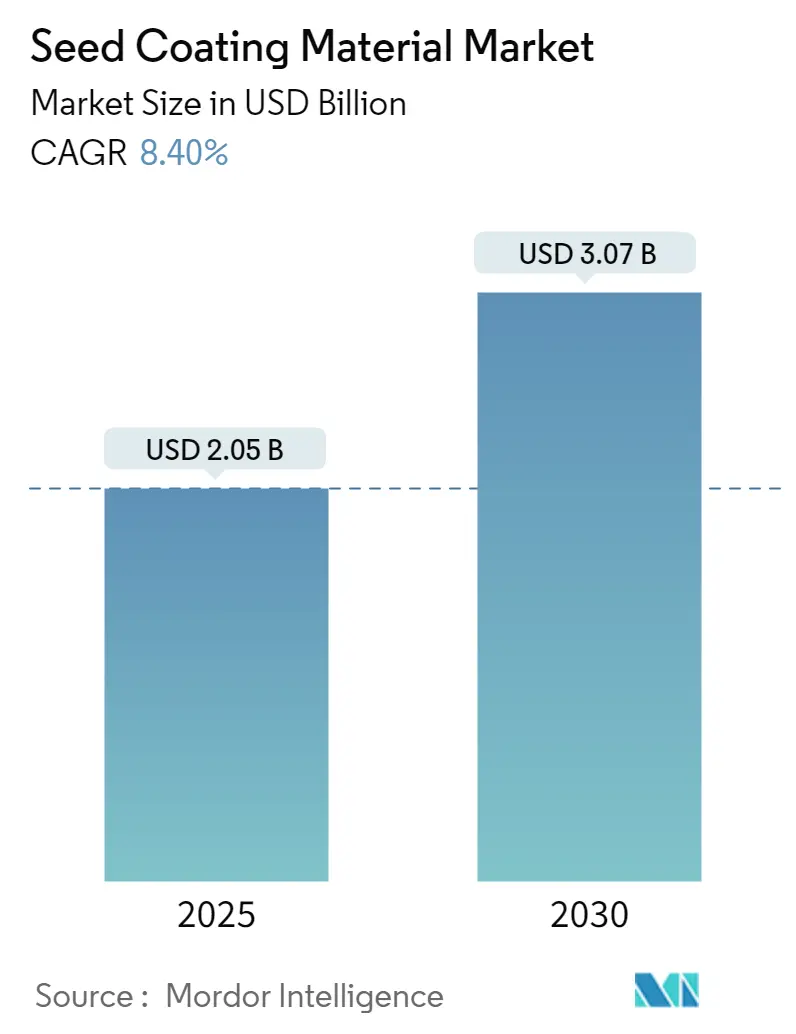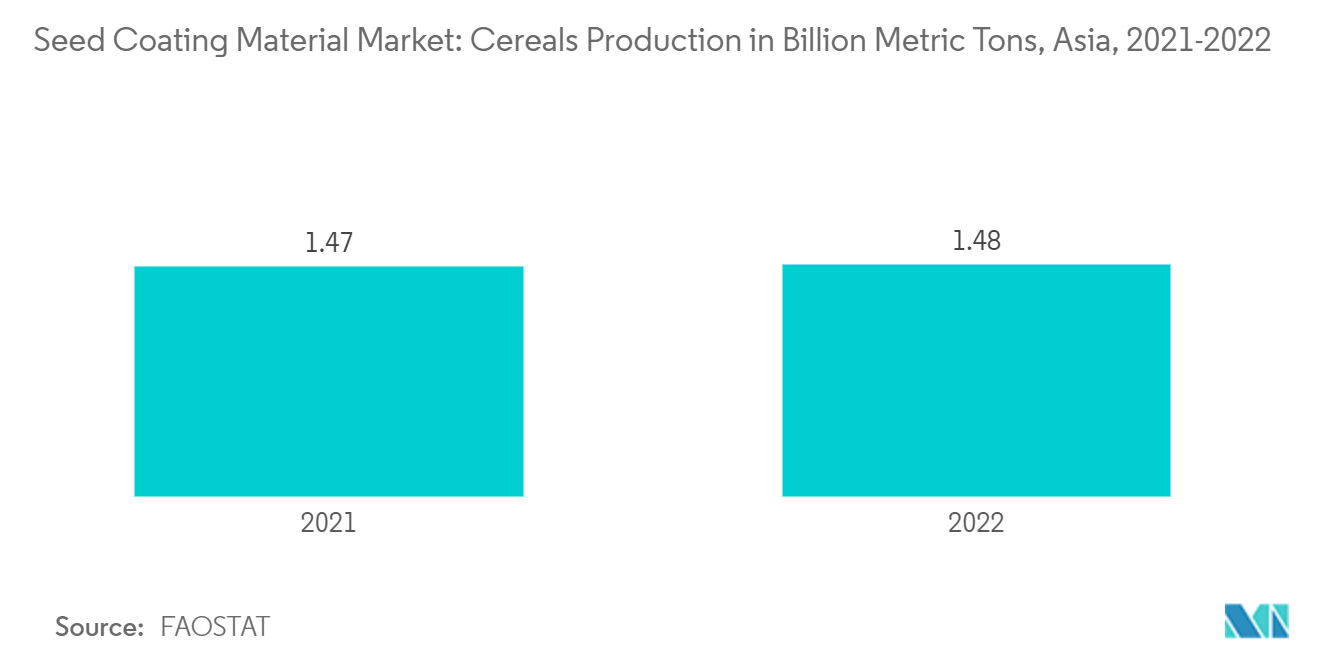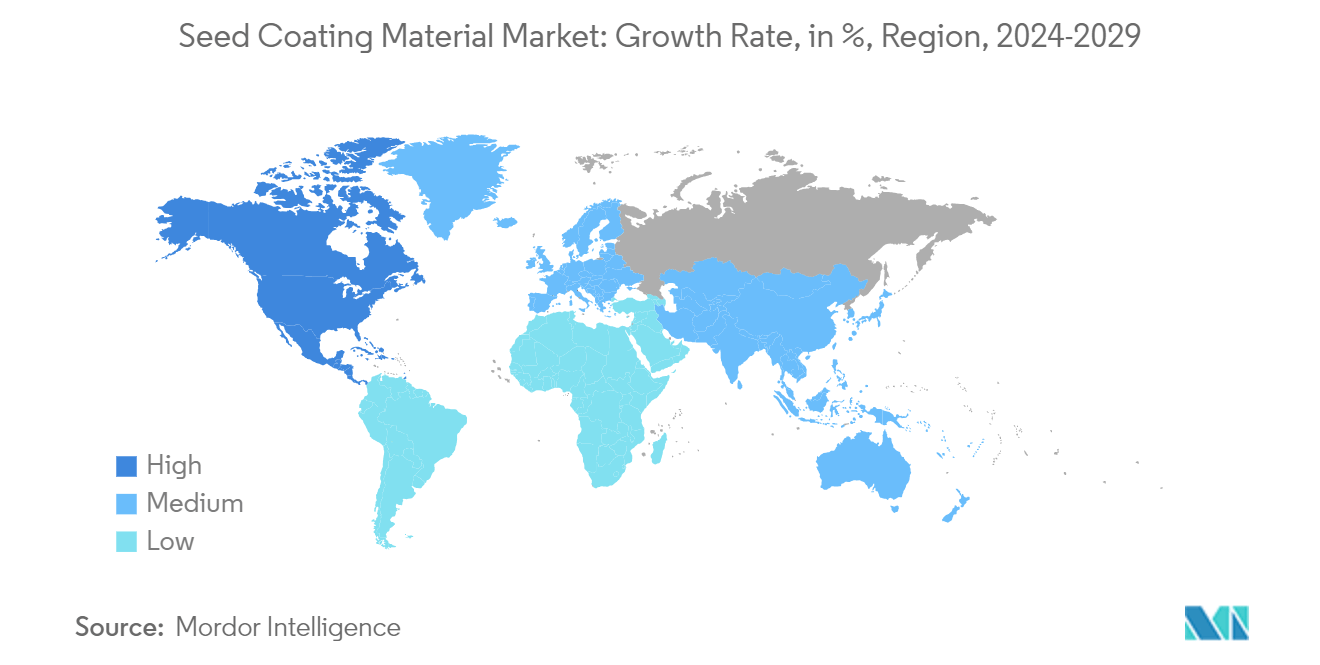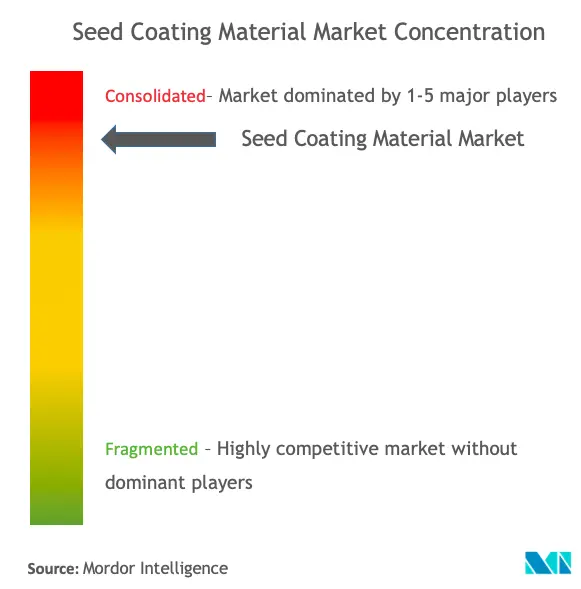Seed Coating Material Market Analysis
The Seed Coating Material Market size is estimated at USD 2.05 billion in 2025, and is expected to reach USD 3.07 billion by 2030, at a CAGR of 8.4% during the forecast period (2025-2030).
- Drastic climate changes have adversely impacted growing conditions, leading to a heightened demand for high-quality seeds. These seeds can be enhanced through the adoption of seed-coating technology. As investments in agriculture rise and modern technologies become prevalent, farmers are increasingly aware of the benefits of material-coated seeds, genetically modified seeds, and hybrid seeds. For instance in February 2022, Croda International partnered with Xampla to develop a biodegradable seed coating, that is free from microplastics. This has facilitated the provision of sustainable solutions that comply with microplastic bans in several countries.
- The seed coating market is actively exploring innovative technologies to enhance the sustainability and efficiency of seed coatings in the field. One such technology is the Micro Emulsion Gel (MEG) technology. This method employs a gel-based coating infused with micro-emulsified active ingredients. Gaining traction in recent years for its sustainability and efficiency, MEG technology applies a thin gel film on seeds, minimizing the loss of coating materials during transport and handling.
- Further, artificially coating seeds enhances the delivery of protectants, symbiotic microorganisms, soil adjuvants, germination promoters, growth regulators, and even colors. Such coatings can potentially decrease the reliance on chemical fertilizers and pesticides. Moreover, introducing beneficial microorganisms via seed coatings has been linked to improved crop yields and enhanced food quality. These advantages are key drivers for the market.
- Developing economies in the Asia-Pacific region, notably India and China, present untapped market potential, offering companies significant expansion opportunities. However, challenges remain. Factors such as high prices and uncertainties about shelf life and vigor deter some farmers from adopting coated seeds. Additionally, stringent regulations surrounding seed coatings pose further market constraints.
Seed Coating Material Market Trends
Grain and Cereal Market is Growing By Crop Type
- The grains and cereals seed coating material market is experiencing robust growth, driven by heightened agricultural productivity demands, the embrace of advanced seed treatment technologies, and a growing commitment to sustainable farming practices.
- With the global population on the rise, the demand for staple crops such as wheat, rice, corn, barley, and oats continues to surge. These grains are pivotal to food security, especially in regions like Asia, Africa, and Latin America. Seed coating materials bolster seed performance, enhancing germination rates and, consequently, yields and crop quality. This has led to a global uptick in their usage by growers, subsequently boosting overall cereal production. For instance, FAOSTAT reported that Asia's cereal production rose from 1.47 billion metric tons in 2021 to 1.48 billion metric tons in 2022.
- Moreover, with limited arable land, farmers face mounting pressure to boost food production. Seed coatings play a crucial role in maximizing crop potential, ensuring healthier and more uniform establishment even in suboptimal soil conditions. The rise of precision farming technologies further amplifies the benefits of seed coatings, promoting uniform plant emergence and enhanced crop management. These advancements, when paired with coated seeds, promise improved plant health and nutrient efficiency, leading to heightened productivity.
- Additionally, grains and cereals face heightened vulnerabilities due to climate change, be it erratic rainfall, extreme temperatures, or soil degradation. In response, seed coatings are being innovatively developed to bolster seeds against these challenges. By enhancing drought tolerance, nutrient uptake, and temperature resilience, these advancements are poised to drive segment growth in the coming years.
North America Dominates the Market
- Seed coating effectively enhances germination and shields seeds from pests. High-value crops, including wheat, cotton, and hybrid vegetables, receive these protective coatings. In North America, as the acreage for these crops expands, so does the market for seed coating materials. For instance, the area harvested for wheat in North America was 24,231,110 hectares in 2021 which increased and reached 24,440,300 hectares in 2022, as per FAOSTAT.
- In North America, the United States stands out as a dominant player in the seed coating market. This is attributed to regulations mandating the coloring of treated seeds and a burgeoning demand for higher yields. Furthermore, factors such as expanding farm sizes, reduced crop rotation, and heightened awareness of bioproducts significantly fuel the demand for seed coating materials in the United States.
- Moreover, corn ranks among the top crops cultivated in the United States, with an increasing percentage of treated seeds using seed-coating materials. While traditional coatings often incorporate chemicals like copper compounds and antibiotics, there's a notable shift towards biologically-based coatings. These biological coatings prioritize soil microbiome preservation and align with organic farming practices. Given these trends, the market is poised for growth in the coming years.
Seed Coating Material Industry Overview
The seed coating material market is highly consolidated, and this trend is likely to continue even in the future. The market is dominated by top players, such as Bayer AG, BASF SE, Clariant International, Chromatech Incorporated, and Incotec Group, which hold significant shares. The United States and certain European countries are likely to become seed coating industry giants, as the companies from these regions are highly focused on merging to capture a larger market share.
Seed Coating Material Market Leaders
-
Bayer CropScience AG
-
BASF SE
-
Clariant International
-
Chromatech Incorporated
-
Incotec Group
- *Disclaimer: Major Players sorted in no particular order
Seed Coating Material Market News
- January 2024: Precision Laboratories has unveiled Aquatrols SL, a novel seed coating solution aimed at boosting seed performance and crop yields. This groundbreaking product not only provides enhanced protection but also elevates germination rates, establishing a benchmark in agricultural technology.
- February 2022: Croda International partnered with Xampla to contrive a completely biodegradable seed coating that is microplastic-free in nature. This partnership will help Croda International lead the seed coating material market and also help in offering enduring solutions in compliance with the microplastic ban in a few countries.
Seed Coating Material Industry Segmentation
Seed coating is a process through which seeds are coated with crop protection chemicals, such as insecticides, fungicides, insecticides, and some other non-chemical/biological products, which protect the seeds from pest attacks. Binders, seed planting lubricants, seed-applied fertilizers, and adjuvants are the major ingredients used in the seed coating process apart from active ingredients/chemicals. The seed coating material market is segmented by ingredients (binders, polymers, seed planting lubricants, fertilizers, adjuvants, and colorants), crop type (grain and cereal, oilseed, fruit and vegetable, and other crop types), coating type (bio-based and synthetic), and geography (North America, Europe, Asia-Pacific, South America, and Middle-East and Africa). The report offers the market size and forecasts in terms of value (USD) for all the above segments.
| Ingredient | Binders | Bentonite | |
| Polyvinyl Acetate (PVA) | |||
| Polyvinylpyrrolidone (PVP) | |||
| Methyl Cellulose | |||
| Styrene Butadiene Rubber | |||
| Acrylics | |||
| Waxes or Wax Emulsions | |||
| Polymers | Polymer Gels | ||
| Super Absorbent Polymer Gels | |||
| Seed Planting Lubricants | Silicon | ||
| Talc | |||
| Graphite | |||
| Other Seed Planting Lubricants | |||
| Fertilizers | Micro-nutrient Dispersant | ||
| Nitrogen Inhibitor | |||
| Solvents | |||
| Adjuvants | |||
| Colorants | |||
| Crop Type | Grain and Cereal | ||
| Oilseed | |||
| Fruit and Vegetable | |||
| Other Crop Types | |||
| Coating Type | Bio-based Coating | ||
| Synthetic Coating | |||
| Geography | North America | United States | |
| Canada | |||
| Mexico | |||
| Rest of North America | |||
| Europe | Germany | ||
| United Kingdom | |||
| France | |||
| Russia | |||
| Spain | |||
| Italy | |||
| Rest of Europe | |||
| Asia-Pacific | China | ||
| Japan | |||
| India | |||
| Australia | |||
| Rest of Asia-Pacific | |||
| South America | Brazil | ||
| Argentina | |||
| Rest of South America | |||
| Middle-East and Africa | South Africa | ||
| Rest of Middle-East and Africa | |||
Seed Coating Material Market Research FAQs
How big is the Seed Coating Material Market?
The Seed Coating Material Market size is expected to reach USD 2.05 billion in 2025 and grow at a CAGR of 8.40% to reach USD 3.07 billion by 2030.
What is the current Seed Coating Material Market size?
In 2025, the Seed Coating Material Market size is expected to reach USD 2.05 billion.
Who are the key players in Seed Coating Material Market?
Bayer CropScience AG, BASF SE, Clariant International, Chromatech Incorporated and Incotec Group are the major companies operating in the Seed Coating Material Market.
Which is the fastest growing region in Seed Coating Material Market?
Asia-Pacific is estimated to grow at the highest CAGR over the forecast period (2025-2030).
Which region has the biggest share in Seed Coating Material Market?
In 2025, the North America accounts for the largest market share in Seed Coating Material Market.
What years does this Seed Coating Material Market cover, and what was the market size in 2024?
In 2024, the Seed Coating Material Market size was estimated at USD 1.88 billion. The report covers the Seed Coating Material Market historical market size for years: 2019, 2020, 2021, 2022, 2023 and 2024. The report also forecasts the Seed Coating Material Market size for years: 2025, 2026, 2027, 2028, 2029 and 2030.
Our Best Selling Reports
Seed Coating Material Industry Report
Statistics for the 2025 Seed Coating Material market share, size and revenue growth rate, created by Mordor Intelligence™ Industry Reports. Seed Coating Material analysis includes a market forecast outlook for 2025 to 2030 and historical overview. Get a sample of this industry analysis as a free report PDF download.

